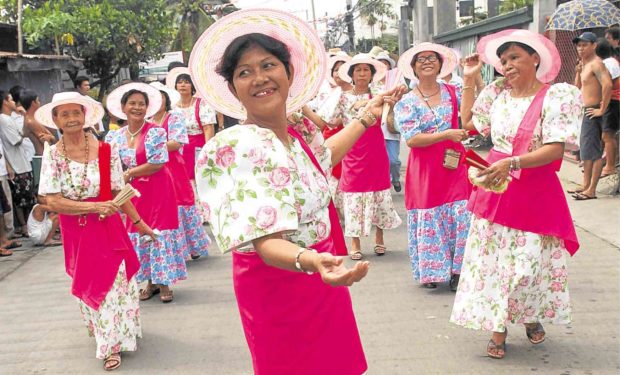Dance of Faith: Charming the deity of fertility

Elderly women of Obando do the fertility dance, presumably for other married women who could not bear children. —RAFFY LERMA
CITY OF MALOLOS — The popular Obando fertility rite dates back to the 14th century, but it was converted into a Catholic festival by Spanish friars when Bulacan was Christianized.
This little-known tidbit came to light in a 15-minute documentary that won the top prize at the first “Sineliksik” of the 2017 Sining Kalinangan ng Bulacan (Singkaban) Festival last week.
“Obando at ang Sayaw ng Pananampalataya (Obando’s Dance of Faith),” which bagged the Best Documentary Film award, asserts that the fertility dance was called “kasilonawan” by the Obando community in the 14th and 15th century.
Married women who could not bear children performed dances “inspired by nature” to draw the attention of a fertility deity called “Linga.”
They used to encircle a tall, improvised phallic symbol, said Ronald Joseph Cristobal, a 39-year-old respiratory therapist in Plaridel town, who wrote and directed the winning film. Cristobal is a member of the theater group Barasoain Kalinangan.
The phallic symbol was replaced by Catholic saints Santa Clara and San Pascual Baylon and Our Lady of Salambao when Spanish priests established the Obando church in April 29, 1754.
Since then, the dances express the devotion to the saints during the Obando feast held every May 17, 18 and 19.
Santa Clara is the patron saint of good weather and the saint to whom a woman prays in order to have a daughter, as well as a faithful spouse, according to Cristobal.
San Pascual Baylon is the patron saint whom Christian women implore when they want to have sons, while Our Lady of Salambao grants good harvest to local fisherfolk.
According to the documentary, the fertility rites in Obando was cited in Dr. Jose Rizal’s novel “Noli Me Tangere (Touch Me Not).” Maria Clara, Rizal’s character, was the fruit of a fertility dance performed by her parents “Tiya Alba” and “Kapitan Tiago.”
Actor Joonee Gamboa, founder and the first artistic director of Barasoain Kalinangan, narrated the documentary.
“Obando at ang Sayaw ng Pananampalataya” is the first film directed by Cristobal.
“I saw how rich our culture was growing up, but I realized so few have put together a comprehensive account [of these traditions],” Cristobal said.
The documentary was researched by Cristobal, his sister, architect Ma. Jenelle Jacinto, and niece Ma. Lynette Francesca Cristobal.
Sineliksik intends to elevate the knowledge and awareness of Bulacan residents about their history, said Eliseo dela Cruz, who heads the Bulacan Provincial History, Arts, Culture and Tourism Office (Phacto) which conceptualized the project along with the National Historical Commission of the Philippines.
“Obando at ang Sayaw ng Pananampalataya” bested 16 other entries. Phacto would mount a free screening tour of the documentary in key universities and colleges in the province.
The Singkaban Festival ran from Sept. 8 to 15. —Carmel Reyes-Estrope














